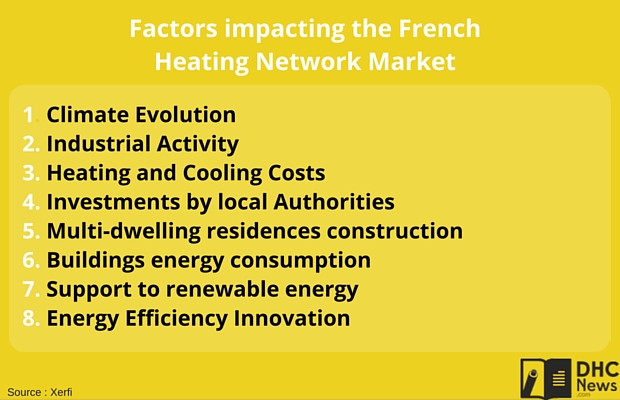The district heating market in France comprises nearly 600 different heating and cooling networks which provide an annual output of about 19,000 MWth. The heating and air conditioning networks serve 3 million French citizens, or 6% of the residential and commercial real estate.
This sector represents a total turnover of 7.5 billion Euros and employs over 22 000 employees. Despite a drop of 0.5% in 2015, largely due to the French government’s energy transition policy, the district district heating market retains a strong potential for development.
It is estimated that the market will double in size over the next 15 years, with 12% of residential and commercial property expected to be connected to the heating and air conditioning networks.
50% of the power is delivered to the Île-de-France, and renewable and recoverable energy represents 40% of the overall energy mix.
The district heating market in France in 2015
In 2015, the sector’s turnover decreased by 0.5% in value (according to Xerfi); this slight drop is the result of a decrease in local government investment in the sector. This decline is partly due to the disengagement of the state in the financing of local communities despite other compensation payments related to the development of the Heat Fund in France.
However, the average winter temperature in 2015 (over the first quarter) was lower than in previous years, which resulted in higher heating costs (+3,5%), thus minimizing the effect of the drop in turnover.
Regulated tariffs increased only slightly (+ 0.8% in March), principally due to the fall in price of natural gas (-10%) over the year.
The geothermal energy market developed a lot over the year, mostly due to its easy availability and its great potential. Investment policies supporting renewable energy also grew, especially with the announcement of the doubling of the heat fund in 2017.
Investments by local authorities were, however, revised downwards in 2015 (-7,5%), due to budget cuts and a high level of public debt.
Which factors impact on the district heating market in France?
According to a recent study, carried out by Xerfi in 2015, 8 factors determine the activity of heat network operators in France.

The forecast for 2016 (and beyond)
Household consumption, in terms of district heating, is expected to rise in 2016 (+4%), particularly due to the increase in construction of apartment complexes (+7,1%), which will be partly linked to networks (Xerfi).
Consequently, the operators are expected to record a 4% increase in turnover this year also, welcome news for a market which has experienced successive declines in 2014 and 2015.
All the indicators are favourable for the development of district heating networks in France over the coming years. We expect to see:
- higher heating costs;
- a 2% increase in manufacturing output volume);
- a revival of investment by local authorities;
- an increase in multi-dwellings residences in France;
- a 7.1% increase in construction work on multi-dwellings residences;
- higher regulated prices in district heating.
The potential of district heating in France
The map below illustrates the potential for the future development of heating networks, compared to the situation in 2012.
Moving your mouse over the area of your choice reveals two pieces of information:
- The network development potential in the region compared to 2012;
- The possible increase in heat deliveries by the networks, for both new and existing networks, in millions of kWh (Source: ENS 2015).
The map clearly shows that district heating and cooling networks have a strong growth potential for the next 15 years, as long as the French government puts financial incentives in place and that elected officials remain aware of, and in favour of, those solutions which best allow district heating and cooling projects to advance.
In February 2016, the European Union, through its heating and cooling strategy, highlighted district heating networks as being the backbone of the energy transition.
All players in the sector should therefore expect significant growth in the drive to meet this major challenge of the cities of tomorrow.


